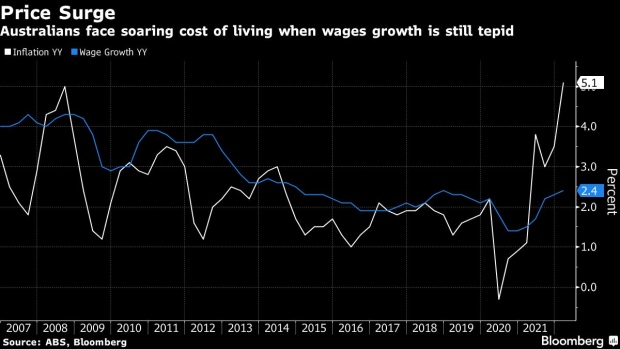May 27, 2022
Australian Households’ Woes Seen Deepening on Rising Power Bills
, Bloomberg News

(Bloomberg) -- Australian households, already struggling with escalating fuel and food prices and still tepid wages growth, will soon find higher electricity bills further straining their budgets, according to Barrenjoey Markets Pty Ltd.
“The storm clouds are gathering,” Barrenjoey’s Chief Economist Jo Masters said in a research note Friday. “Electricity bills are the latest on the list of essential goods and services seeing significant price increases and wages are not keeping up. Households are under-estimating the headwinds.”
Australia recorded its largest fall in real wages in two decades in the first three months of the year, with inflation running at double the pace of pay gains. While the economy still looks solid given rising consumption and very low unemployment, there are doubts over the durability of the expansion.
Masters cited Barrenjoey’s recent discussions with retailers and suppliers that suggested discretionary spending weakened in the past two to three weeks. Australia’s central bank raised its key interest rate for the first time in 11-1/2 years this month to 0.35%.
Australians have so far escaped the electricity price spikes seen in Europe and the US. But a soaring price of coal -- used in power generation -- prompted the nation’s energy regulator to flag price increases from July 1.
These contracts only cover about 10% of households, but act as a price signal for other floating and fixed rate contracts, Masters said. “Moreover, network costs -- which make up about 45% of the household bill -- have also been rising,” she said.
On average, Australian households spend A$263 ($188) per month on electricity, gas and other fuel bills, equivalent to 3.1% of average earnings. A 5-10% increase equates to A$13.20 to A$26.30 per week, according to Barrenjoey calculations.
“This comes alongside higher food prices, rising petrol prices, higher mortgage repayments,” Masters said. “Importantly, this is unlikely to be a one and done price rise for electricity and gas. Futures markets suggest ongoing price increases. We expect another set of price increases this time next year.”
©2022 Bloomberg L.P.






